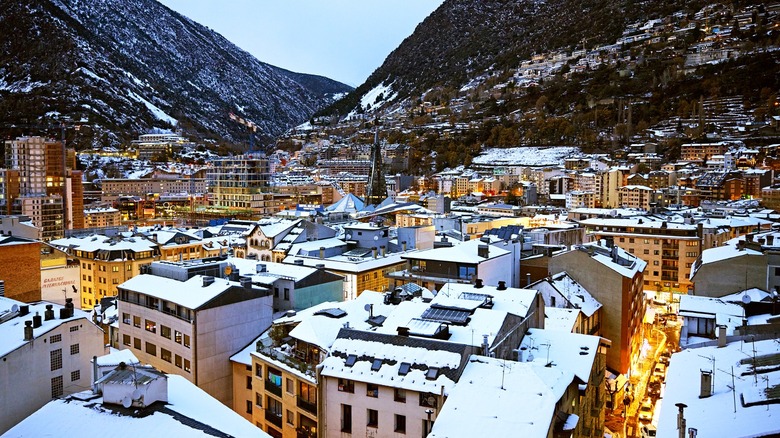Rick Steves Says This European Country Has The Charm Of A 'Giant Shopping Mall'
Andorra is a tiny nation of approximately 80,000 people nestled in the Pyrenean mountains that measures about 13 miles by 13 miles, which is roughly equivalent to the size of Mobile, Alabama. Travel broadcaster Rick Steves first visited the nation in the 1970s and was unimpressed despite the dramatic scenery. Steves described Andorra la Vella, the country's capital, as a "big Spanish-speaking Radio Shack" owing to the preponderance of duty-free electronics stores.
Andorra is a relic of Europe's feudal history of kingdoms and principalities. In the 13th century, a marriage between the French and Catalan nobility established control of Andorra with the Bishop of Urgell. Disputes among immediate descendants caused not prolonged conflict but an agreement that Andorra remain neither Spanish nor French — a consensus that has lasted for hundreds of years.
This blur of Franco-Iberian culture does not help Andorra's identity. Locals claim to be entirely independent and that may be true on a legal basis, but what does that mean culturally, politically, and financially? Pyrenean isolation kept Andorra poor until the 20th century, when a new economy was built around banking, duty-free shopping, and iconic, easily accessible ski resorts. Despite all of this development, Steves' departing sentiment was that he had visited the Principality of Andorra so his audience didn't have to. Helpful, perhaps, but as with all things in life, you should arrive at your own conclusion.
Skiing and hiking in the Andorran Pyrenees
Skiing or snowboarding — which is easier to learn? Andorra's slopes give ample opportunities to practice both at resorts such as Pas de la Casa, Pal, Soldeu, and Arinsal, which offer a combination of wide-open beginner areas, well-groomed runs, and expert terrain for those seeking a challenge. These resorts are not the cheap destinations they once were, but the increased prices at least reflect better infrastructure, especially the modern lifts.
Andorra's resorts are spread across two main areas: Grandvalira and Vallnord. Grandvalira, the largest, is home to 140 slopes and the town of Pas de la Casa, the de facto hub of Andorran skiing. Pas's bars and B&Bs attract large, young crowds looking for parties and intermediate slopes, but the town has wider appeal than that. Beginners can enjoy tailored ski lessons, and advanced skiers will find challenging black runs. For those seeking alternative snow adventures, Pas de la Casa offers dog sledding (mushing), snow tubing, and exhilarating snowmobile rides through stunning mountain landscapes.
Andorra's second major area, Vallnord, includes the Pal and Arinsal resorts, which are quieter and family-oriented, making them perfect for novices. Rick Steves may prefer breathtaking Alpine hikes, but Andorra is an invitingly compact and dynamic location for European skiing.
Wining, dining, and duty-free shopping
According to the CIA's World Factbook, Andorra consumed 10.99 liters (around 2.9 gallons) of pure alcohol per person as of 2019, and this prodigious figure is largely attributed to the popularity of wine, one of the country's national drinks. Vineyards such as Borda Sabaté 1944 and Casa Auvinyà are built into steep mountain slopes where machinery can't reach, so harvests are done by hand. This labor-intensive process can reduce output to just 1,200 kg of grapes (over 2,600 pounds) in a country where wine consumption hit 59.6 liters (15.7 gallons) per capita in 2018 (via Around the World in 80 Harvests). Despite this, Andorran winemakers have successfully adapted to the harsh, high-altitude conditions and maintain a thriving industry dedicated to small-batch wine with distinctive Pyrenean terroir flavor.
There are many wine bars catering to the local and international thirst. Restaurante El Crosto, for example, is among Andorra la Vella's most reputable eateries, pairing local varieties with steak, rabbit, and sumptuous desserts. Nearby La Tapeta de la Vall is another inviting spot, popular for its padron peppers, prawns, and charcuterie. For something more dramatic, visit Coll Blanc KSB, a French restaurant perched over 8,000 feet on the pass between Pas de la Casa and Grau Roig. Expect panoramic views and a menu specializing in en duck magret and cassoulet.
Andorra's last distinction — and the feature that earned Rick Steves' scorn in his 2007 article, in which he wrote, "Today it retains the charm of a giant shopping mall," — is its duty-free shopping. The principality's 4.5% sales tax nets big savings on electronics, perfumes, comestics, and other goods in the classy boutiques along the Avinguda Carlemany shopping street and in the four-story Illa Carlemany shopping center — the hub of Andorra's low-tax industry.


